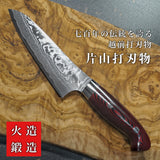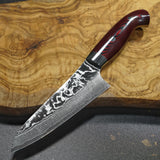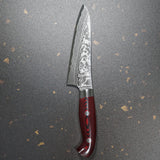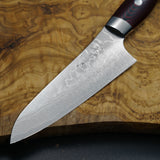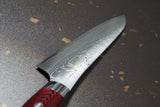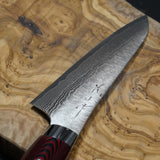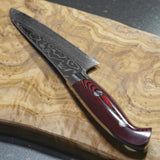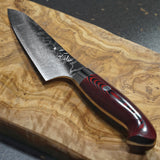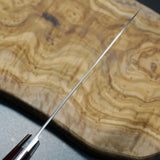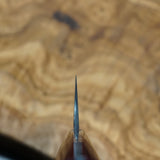Yuta Katayama Super Gold 2 Damascus Petty 130mm Knife Akatsuki

Blacksmith: Katayama Yuta
Type: Custom Petty / Utility Knife (Double bevel edged)
Blade Material: Super Gold 2 SUMINAGASHI (Damascus) Clad Stainless Steel
Core: Super Gold 2 (Powder Stainless High Speed Steel)
Blade Length: approx 130 mm (5.1 ")
Total Length: approx 242 mm (9.5 ")
Thickness of Spine: approx max 2.3 mm
Blade Width: 41 mm
Weight: around 135 g (4.7 oz)
Handle: Micarta
HRC: 62-63
Made in Japan
※ This Damascus Blade is not black but silver.
※ As each knife is handcrafted, slight variations in size, weight, and finish should be expected.
The knives made in Echizen city are called "Echizen Uchi(Forging) Hamono(Cutlery)". The art of making Japanese kitchen knives has a history of about 700 years. Echizen Uchi Hamono is designated as "Traditional Crafts" by the Minister for Economy, Trade and Industry. These knives are forged by blacksmiths, these knives are harder to be chipped and the sharpness continues longer. The organization of material changes homogeneously, it is observed by a microscope.
Yuta Katayama has eight years of experience under Master Saji and became independent in April 2021. The finish of his knives are always delicately beautiful. He makes not only kitchen knives but also outdoor knives, which has been exhibited at the knife show in Seki City. His knives offer easiness of grip, the cool design and originality, so cool! To tell the truth, Most Japanese have never seen like this acid etching damascus blade and knives with iron wood handle.
The elegant wave pattern, commonly known as "Sumi Nagashi," is one of the treasures produced by Japan's cutlery tradition. Inspired by the craftsmanship of Japanese swords (Katana), the blade is constructed from a combination of high- and low-carbon stainless steel. The blade's design helps release ingredients as you cut, making it a durable and versatile kitchen knife suitable for both home and professional use.
NIMAI-HIROGE(Spreading Two Sheets)
NIMAI-HIROGE is the special skill in Echizen city only. It is outstanding method. The spine of blade requires thickness for sturdy and around the edge needs to spread to thin edge in order to improve sharpness. These requirements are met by hitting two blades together at a time. If two blades are hit together at a time, the temperature is hard to fall. Two blades prevent to be cool down fast. So blacksmiths can hit two blades many times in a short time. If only one blade are hit, the blade is cool down fast, they must put it into kiln for heat again. Then carbon runs away from the blade, the blade will become weaker. This skill looks easy, but it is very hard. Even a skillful blacksmith could not do this for 5 years.
About "Super Gold 2"
Super Gold 2 is registered trademark of Takefu Special Steel Co Ltd. A large quantity of high alloy ingredients are included by powder metallurgy. And it is super high quality steel that rich in high corrosion-resistant, high hardness, high toughness, high wear resistance. Though this HRC is high, it is easy to relatively re-sharpen it. And The edge retention is outstanding. Thus famous Japanese Chefs also prefer this steel.
NOTE:
Thoroughly wash, dry, and wipe the knife after each use to prevent rust. If rust appears on the blade's edge, remove it with a sharpening stone. For rust on the blade itself, use a mild cleanser (for stainless steel) or a fine-grit scourer (for iron steel), being mindful of potential scratches.
To prevent damage, avoid twisting the blade or striking it against hard surfaces. Cutting frozen foods or bones can chip or break the thin, sharp edge of Japanese knives. As these knives are meticulously handcrafted, slight variations and minor scratches may naturally occur.















